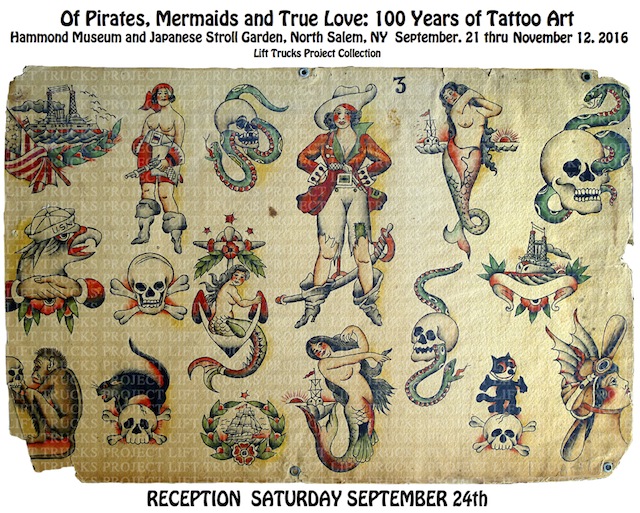
Save the Date Opening day is Saturday, September 24.
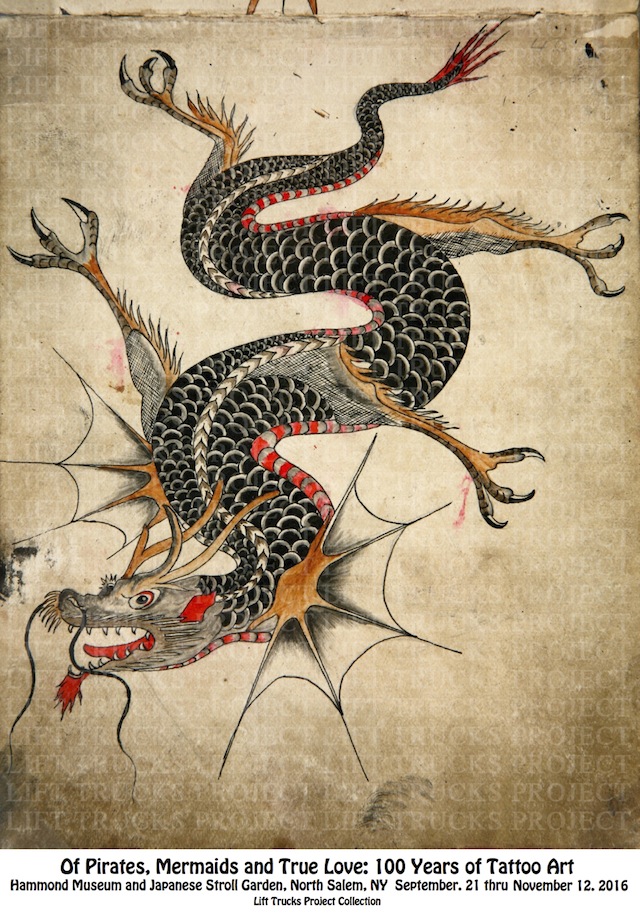
Caveat Emptor
Trader Vics' legacy.

The guy's name is Harry Lawson, right?

Recently looked at a sheet that was unidentified. It's early and nicely drawn. We wanted to try and identify the author, if possible.
There's a date; May 20th 1930 written in pencil and erased under the eagle wings of the crossed equator design. Which caused us to look further. Scotty in the Lift Trucks Lab found another erased set of letters at the bottom of the sheet. Looked like "...rry V Law...n. He then looked at it a different way by flipping colors on the computer to a negative. Almost like a blueprint. You can see it clearly in person, not so much in the photo (apologies.) But you get the idea. All falls into place and says in all caps; HARRY V LAWSON.
Not a bad way to check for signatures on a sheet. Flipping some colors will work better than others. Old computers sometimes have a color matrix rotation system button. On newer models, try Photoshop or iPhoto and swap out one color for another.
One tell was the unique style of feathered shadows under the feet of the women. A black line with fade cast. This is on other Lawson's in a book. Shows up here on the ukulele girl and pirate lass giving stylistic evidence, along with the block letter signature, that sheet is most likely by Harry V. Lawson.
Maybe another reason to dig back into into the slag heap of unidentified tattoo flash sheets.

Click image to see enlarged. block letters: HARRY V LAWSON
Goodnight Irene

Irene Woodward, also known as La Belle Irene, was a tattooed lady who performed during the 1880s. She made her New York debut just weeks after Nora Hildebrandt to great fanfare, including a report in the New York Times. She worked at Bunnell's museum and successfully toured Europe. Onstage, she claimed to have been tattooed by her father, and, in a break from the usual tales of forcible tattooing, claimed she actually wanted the work done. Woodward was actually tattooed by Samuel O'Reilly and his then-apprentice Charles Wagner. At times, she claimed to have been inspired by having seen Constantine. In 1883, she married a showbiz man named George E Sterling with whom she had a son, also named George, and spent 15 years in the circus.
She died in December of 1915 at the age of 53 in Philadelphia, Pennsylvania.
Info courtesy of MBEzine.

Here's a sketchbook page from the sketchbook of Samuel F. O'Reily, Irene Woodward was illustrated by him.
Ed's Tatoo Parlour
Tattooist: How about a butterfly on your hip?
Teenage Girl: Its like you read my mind!
Will be stopping by Ed's. Location rocks, stumble on over with me, matey. Must be lovely, rear of Finn's bar. Although not a confidence builder having the word "tatoo" misspelled on his shingle. All doubts were quickly dispensed seeing the classy English spelling of the word Parlour. Wonder what city this was in? Must have been back east somewhere. I don't exactly remember. Heh, heh. You going to finish that Rob Roy?

Aloha, Baby

Here's a sheet of tattoo flash that surfaced at an obscure auction. Story was that it originally came through a swap meet in Northern California, not sure what one but maybe the now defunct Marin City. Which was a very cool place where lots of hippies would set up selling stuff from wealthy guys like the Jefferson Airplane musicians. Phil Ochs widow was there a lot. Kind of sad actually but she had nice things for sale and was a nice person. A well heeled town with good items not just sand candles and yarn dream catchers but expensive bikes, early electronic gear and mint Bill Graham Fillmore posters.
Anyway the auctioneer said the guy who owned the sheet of flash remembered that he got it from Albert Morse. Mr. Morse was a famous comic book artists' lawyer (don't mention his name to comic book guys, as they will spit and fume.) Unhappy dealings! They cry.
Albert Morse traveled the country and documented many tattooists. A hero in this world as he preserved history, wrote The Tattooists and had a great tattoo art show at the Oakland Museum of Art 25 years ago. Brought tattoo panels out of back rooms onto museum walls and the public eye.
We originally thought this piece might be Owen Jensen's as the girl and peacock is something he drew occasionally. But the fine line drawing just isn't his. It kind of looks Californian even though it says Aloha Hawaii. Beautifully done, it and now positively identified as an Earl Brown sheet.
Crutch n Tats
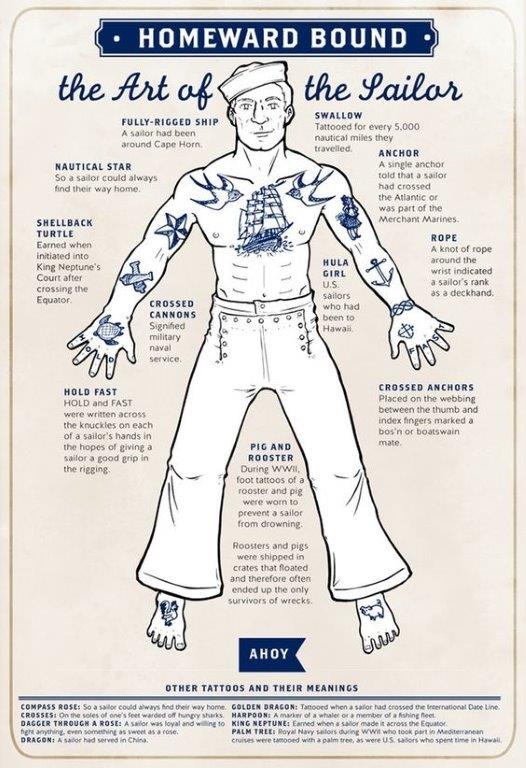
Some interesting old sailor Tat meanings....read at very bottom..= the Crosses tattooed on soles of feet to ward off sharks if a ship had fell out from beneath you...
- Crutch
I Scream, You Scream
So, the real question is: Does The Scream still shock? John Canaday, the famous New York Times art critic, said (to paraphrase) of the Mona Lisa; We can't see it anymore. We see the icon, fame and the money it's worth. Paintings can become items of value. They lose the expression of the times, the artist or whatever.... There it is, The Famous Painting. He may have had a point. The Scream has turned the corner becoming a historical icon like the Mona Lisa, The Sistine Chapel and Picasso's Les Demoiselles d'Avignon.


At the Neue Galerie you follow the line governed by a guard slowly letting us into the dark, closet sized, burgundy painted room with the icon. We look at other yelling angst ridden portraits along the way.
Some of the other pieces in the show stand out more. Like the Nolde portraits and the wonderful pink street painting by Kirchner. But they all went to school on Munch's achievements. They could not have done their expressionistic paintings if he had not gone first. Probably the first guy to really explore inner horror. As opposed to event caused horror like Goya's war scenes.
Munch's work kind of looks creepy and hospital room like. He apparently had a girlfriend who told him she was dying or something. He rowed a boat in the middle of the night to go see her on some God forsaken island. Go ahead look the story up on Google. So anyway she is not sick, laughs loudly and says "Just kidding." He is so streamed that he rows home under a black sky and pretty much swears off dating for the rest of his life.
See the show. It's a wonderful gallery and we are all lucky to have it here.
Munch and Expressionism at the Neue Galerie, NYC until June 13.
Dispatch from Crutch.
" Screwed ,Blued, and Tattooed "...which normally in sailor tongue meant you had done it all in that Port of Call...and at this joint you certainly could make that statement a reality....in my day ladies mostly imports from Argentina ....a wild wooley place....

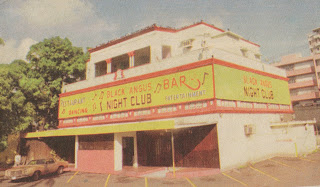
Eagles, Two Maidens and a Tiger
This article is by Chuck Eldridge at the Tattoo Archives in Winston-Salem, North Carolina. Reprinted here by his kind permission. Mr. Eldridge is a tattooist, and an acknowledged historian on the subject of tattoo history. If there is anything you want to know about the Tattoo World, Mr. Eldridge is your man.
http://www.tattooarchive.com/
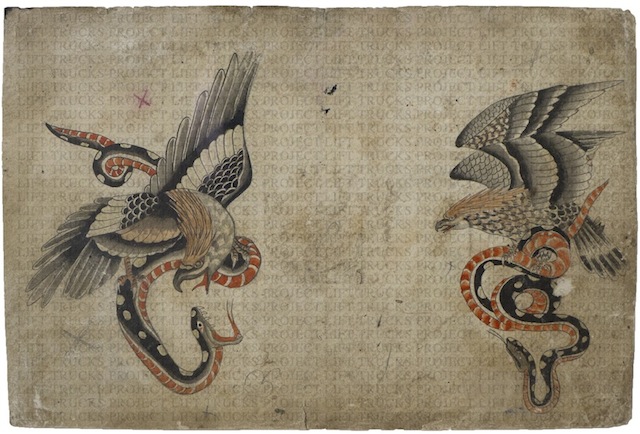 George Burchett George Burchett was probably the most famous tattooist of his era, which spanned from 1890 through 1953. Tattooing in London through two World Wars, Burchett catered to both the rich London society and the poor alike.
George Burchett George Burchett was probably the most famous tattooist of his era, which spanned from 1890 through 1953. Tattooing in London through two World Wars, Burchett catered to both the rich London society and the poor alike.
Born George Burchett Davis in 1872 in Brighton England, George did his first “scratching” (as he described it) on his schoolmates. One of his first customers was his younger brother Charles, who at the age of four or five was wiling to pay the large fee of a stick of liquorices for the pleasure of being scratched by George.
George Burchett joined the Royal Navy at the age of thirteen and found that his ability to “scratch” was welcome. Navy discipline proved too much for the young George, so he jumped ship in Tel Aviv and did not return to Great Britain for twelve years. In order to avoid the authorities George Burchett Davis dropped his last name and became George Burchett. During this part of his life, he worked as a tram conductor and a cobbler, but continued tattooing part time. In 1900 he became a full time tattooist. During the next half century and until his death in 1953, George Burchett created one of the largest tattoo practices in the world.
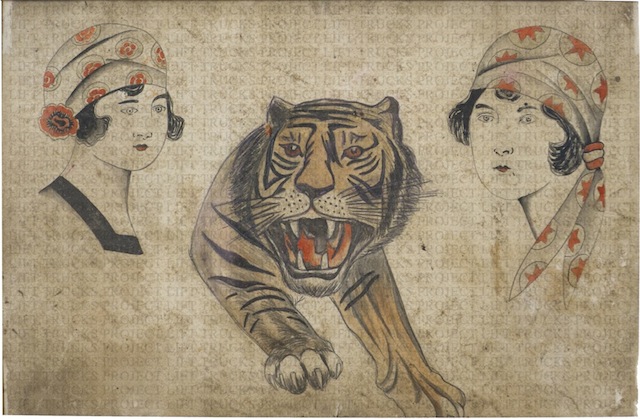 Charles Davis
Charles Davis
Charles Davis followed in his older brother's footsteps into the tattoo world, but never received the acclaim that George did. The brothers worked together and operated shops separately for many years. George and Charles were just a few years apart in their ages. It's difficult to tell them apart in photographs today, with both of them dressed in white shirts, vests and ties, and sporting well-trimmed mustaches and matching shoes! They both even liked to work in white medical smocks. Their tattooing styles were so similar that it is difficult to tell their tattoo designs apart. In later years Charles stepped away from tattooing, and in the 1950s George wrote that Charles was active in the insurance business.
Picasso, the painter who changed sculpture forever
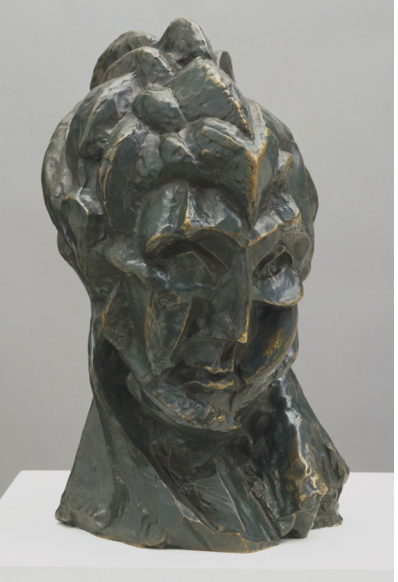
Woman’s Head (Fernande) 1909, Bronze
To attend the Picasso Sculpture Exhibit at MoMA is to witness the secret workings of a relentless creative mind. Never schooled in sculpture, he was free to explore its potential, without fear of failure. Coupled with his sense of playfulness and rebellious outlook, he worked in the gap between painting and sculpture. He made no assumptions about what a sculpture could be, and he didn’t let convention get in his way. Richard Serra said, “Picasso seems to be actually more inventive in sculpture than in painting.” What few realize is that the greatest painter of the 20th century was also the greatest sculptor of the 20th century. To see this show is to know the canon other serious sculptors must compare themselves.
Picasso once famously said, “Good artists borrow, great artists steal.” and the artist he stole the most from was Cezanne, a painter who not only painted what he saw, he painted how he saw. Cezanne eschewed staining, “sculpting” his work with thick brushstrokes, and with multiple perspectives, he reduced his pictorial elements to cubes, cones, and cylinders. From this starting point, Picasso created Analytical Cubism. Picasso took Cezanne at his word, and he painted cubes that fractured the picture plane, creating a breathing space for shapes to float in and out. Facilitated by the freedom this structure offered him, he investigated multiple views of perception. Picasso painted some of his most provocative works of art at this time, and propitiously, he continued to work in sculpture.
The first room in the show shows how quickly Picasso progressed in his early 1903 to 1909 period. From a sentimental bust of a bronze harlequin to a primitive wood sculpture of a nude, you are immediately led to his breakthrough work, Woman’s Head 1909. Modeled out of clay, and then cast in bronze, Woman’s Head, portrays his lover, Fernande, from multiple viewpoints, as partly buried cubes emerge from a block of clay. Picasso tries to release his cubes and make them float, but traditional sculptural processes hold him back. Unlike his paintings, there isn’t any air in this work, which limited his potential for spatial exploration. Multiple viewpoints stuck in the mud of the clay, lack clarification. Luckily, his painting process offered a solution to his predicament.
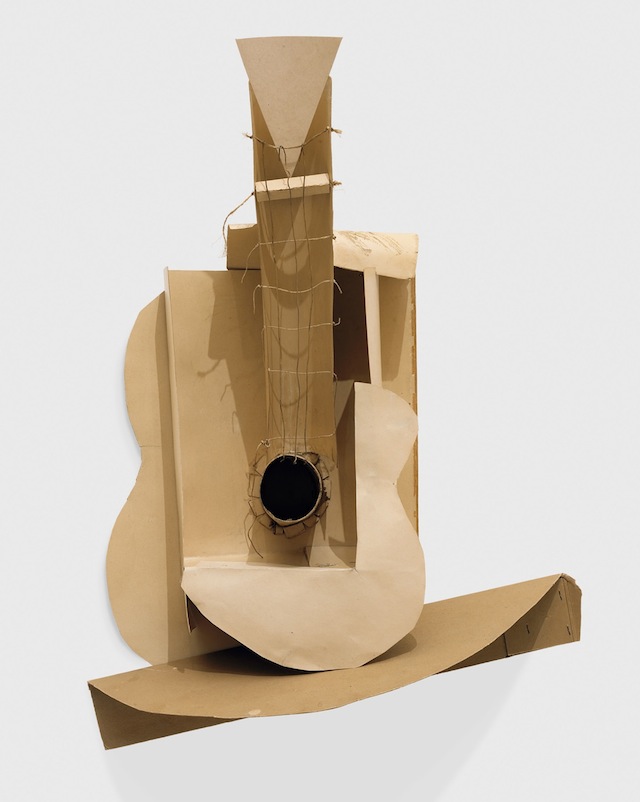
Still life with Guitar. Variant state Paris, assembled before November 15, 1913, Subsequently preserved by the artist Paperboard, paper, string, and painted wire installed with cut cardboard box
While working on his still life paintings, Picasso would use sketches, or maquettes, as the reference for his work. One of these sketches was a three-dimensional cutout of a guitar, handmade of paperboard, paper, string and painted wire, glued together. A photo of it exists as a centerpiece in a three-dimensional tableau made of paper cutouts. Once finished, Picasso had an insight. Why couldn’t the sketch stand alone and be the sculpture? That way, it would free up the negative space of his work allowing shapes to float, as they did in his paintings, allowing multiple viewpoints to mesh with each other. This bold move demonstrated a rejection of the lofty subject matter of sculpture. This wasn’t a statue of a goddess, a general on a horse, or even his mistress. It was a sculpture of an inanimate object. Of a guitar! Then in 1916, Picasso folded up the paper guitar and put it away in a box. It remained there for 64 years until the MoMA acquired and displayed it again, soon after the artist’s death. Fortunately, before mothballing the paper sculpture, Picasso decided to make a more permanent version of it in 1914.

Guitar, Paris, after mid-January 1914 Ferrous sheet metal and wire
Guitar 1914 wasn’t made from clay, wood, or marble. It was made with metal. It wasn’t carved, chiseled, or molded. It was constructed. It even had lines (the strings were made of wires). It hung on a wall. What was it then? With Guitar, Picasso resolved a conflict between painting and sculpture by introducing a strange hybrid. Some called it pictorial sculpture.
Here, Picasso answers ‘why’ questions. Why is sculpture always about the human form, when it could be of an inanimate object? Why can’t it be assembled, when you can construct it out of metal? Why does it have to be on a pedestal, when it can hang on a wall? Why does sculpture have to be so serious, when it could be fun? By challenging sculpture’s very nature, Picasso brought a new energy to the medium. The poet Andre Salmon observed, “We were delivered from painting and sculpture, liberated from the imbecilic tyranny of genres.” Guitar 1914 set the stage for the greatest sculptural exploration and innovation of the 20th century.
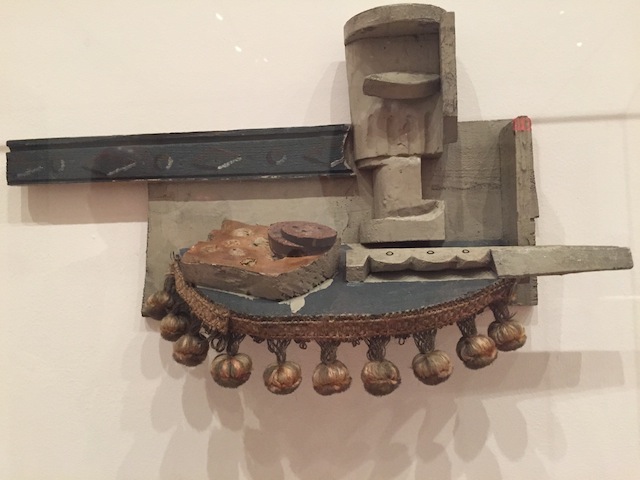
Still Life, 1914, painted pine and poplar, nails, and upholstery fringe. About 12 inches high.
Still Life, 1914 is the first sculpture that made fun of sculpture. Instead of carving, he paints pine and poplar wood and nails them together. Although still life as a genre is within the purview of painting, Picasso boldly makes it the subject of sculpture. By portraying a workman’s lunch, he offers a sardonic commentary on the ‘high’ ambitions of ‘Art’. (A Dutch Master, 17th century feast, it isn’t.) Haphazard sawn wood, machined and hand carved, refute the journeyman’s aesthetic of refinement. Further blending painting and sculpture, he uses paint to distinguish the surface of the glass (glossy) and the rest of the tableaux (matte). The addition of tasseled upholstery fringe, a found object integrated into the piece, proffers another snub at the craftsmanship, giving the piece an air of insouciance and whimsy. This daring act, incorporating real objects into sculpture, unleashed a creative fervor that resonates to this day. But this is just the beginning for Picasso, and there are so many more rooms to go through.
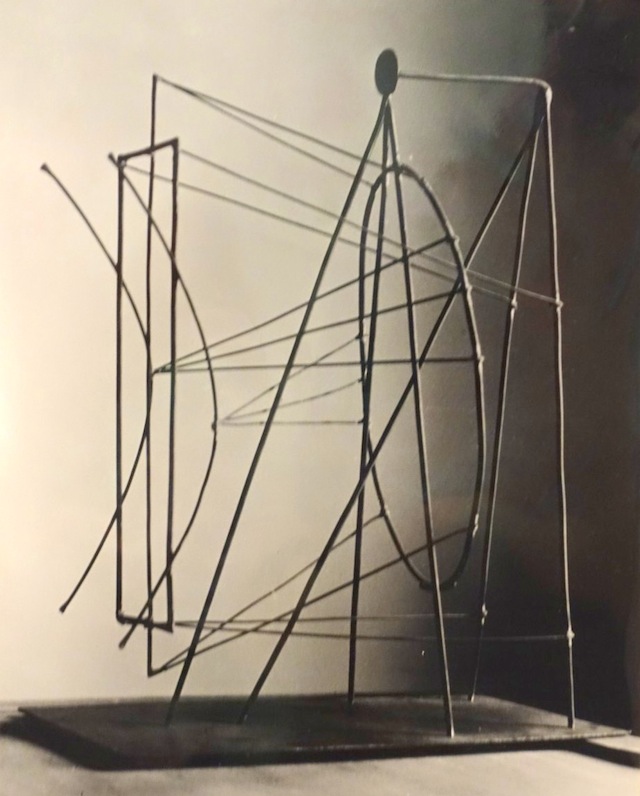
Pablo Picasso. Figure. 1928
Picasso’s quest to have his sculpture breathe led to another breakthrough, Figure, 1928, a rejected study for the tomb of his friend Apollinaire. Once again, a painter’s perspective creates a new sculptural form, but, this time, using Surrealist imagery. Inspired by the strings in his guitar sculptures, he created a piece made entirely of welded wire. A contemporary art dealer declared it ‘drawing in space.' Sculpture as drawing, freed up the medium, allowing new avenues of creativity by using line and air for expression. Once again, Picasso’s disregard for the status quo showed the way for artists to use unorthodox materials and techniques.
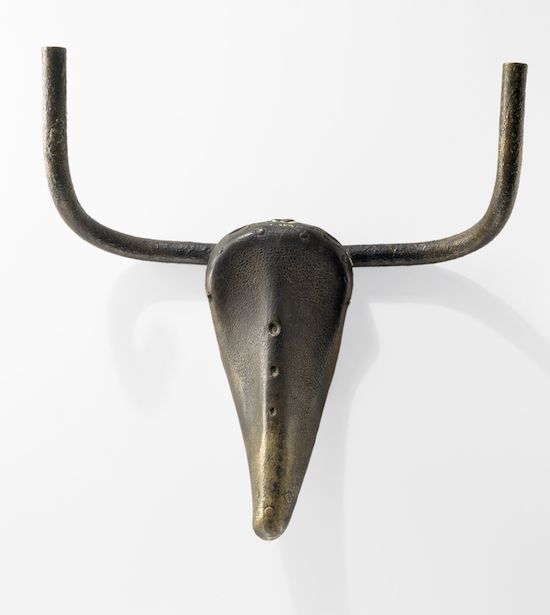
Picasso's 'Bull's Head' Paris, spring 1942 Bronze, cast in 1943
Assembled out of a bicycle seat and handlebars, Bull’s Head evokes a smile. Bold simplicity and a good coupling of two disparate bicycle parts surprise with a depiction of a bull. But then, Picasso takes it a further step, as he casts the assemblage. Now, Picasso comes full circle with another desecration. After embracing the commonplace by incorporating it into his art, he now sanctifies it with bronze. The 19th century must have been rolling in its grave.
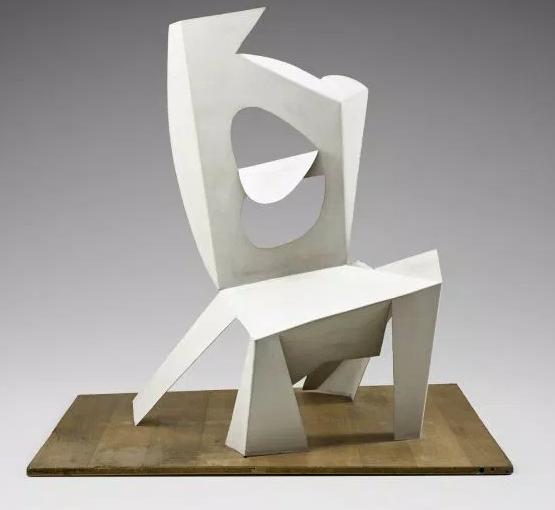
Chair Cannes, 1961. Painted sheet metal, Musée National Picasso–Paris.
What Figure 1928 did for the line, Chair Cannes did for shape. This kooky sculpture questioned the fundamental processes of its medium. First cut out of paper, folded, and then flattened out (at this stage Picasso said it looked like a chair run over by a steamroller), craftsmen then bent a single sheet of painted metal, based on the paper template, to create an art object. Made of only one part, he manipulated the material of the work itself, to create a complex piece without soldering or welding. Only gravity holds it together. Bent and turned planes create their own negative space. With a mundane object as subject and a simple shape as a sculptural form, with bending as process and gravity as glue, Guitar Cannes, advanced both the mental and visual gymnastics of Picasso’s art – not bad for an 80-year-old.
To tour this show is to explore the creative mind. How are new ideas formed? How does one find the confidence and courage to embrace them? Picasso shows the way with his unrelenting curiosity, reassessment of assumptions, and rejection of category norms. He asks big questions by challenging the opposing prejudices of painting and sculpture. His nonchalance enabled risk taking, with a take-or-leave-it attitude. What is the secret to Picasso’s prolific creativity? He had fun.
Thomas McManus is a writer, artist and professor at Fashion Institute of Technology in NYC.
Restoring Tattoo Drawing
How to clean up a century old piece. Removing later additions and bring back to original.
Picasso vs Sailor Jerry
We have been through the Picasso sculpture show at MoMA twice. It did not get better. Seemed careless and sloppy in both thought and in execution. He did not stick a baby cake server on a pile of Playdough once, but 30 times over. Our artist friends enjoyed the "playfulness" or some such rot. They said he explored the exploding of imagery. We say 3d telephone doodles.
Let's compare: Who had a tougher audience?
Picasso had to amuse laudenum addled bohemians lounging around Montmarte cafes as Nazi's paraded down the Champs Elysees.

Pablo Picasso

Picasso sculpture from MoMA.
Sailor Jerry created art for tough guys on shore leave, repairing from Pacific Rim battles with the Japanese.


 Sailor Jerry.
Sailor Jerry.
We know whose art we have on our walls ,Matey!
Charle "of Malta" Parnis

Compare these three head shots:
1. From Lift Trucks contributor.
2. Long sheet found in Dusty Rhodes’ studio.
3. Charlie “of Malta” Parnis, early 1900s. Collection of Hanky Panky, Amsterdam Tattoo Museum. From Pierced Hearts and True Love: A Century of Drawings for Tattoos, The Drawing Center.
Lab staff sent packing along with our scientific laboratory of expensive machinery. We now trust in knowledge the passed down through generations, the good eyes and common sense of our friends in the tattoo world. Great analysis that has shed light on a previously unexplored subject regarding tattoo flash painted over 100 years ago. Difficult task indeed.
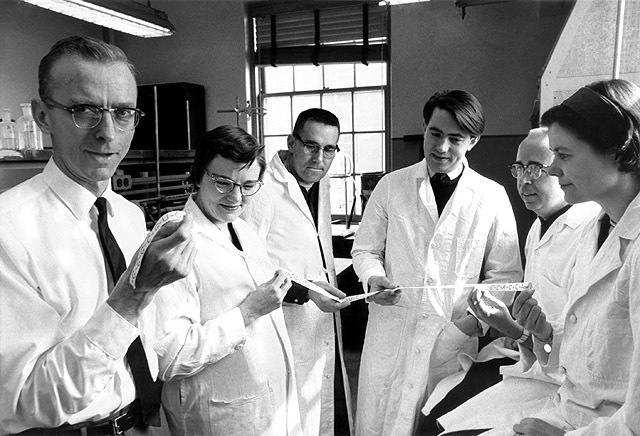 Clear out your desks.
Clear out your desks.
 Schools out forever for these Lift Trucks employees and their shoddy research.
Schools out forever for these Lift Trucks employees and their shoddy research.

Fill high the dumpster!
We now trust the eyes of our friends. Many thanks again to Messrs. Skuse & Shudehill.
We now must have any help with information regarding the mystery of Charlie,of Malta,Parnis.
First question: Did he live ever in Malta, or was he an Englishman with Malta as his calling card, much like "Brooklyn" Joe Leiber? A man who reportedly never set shoe leather down once in the good borough.
Of Dragons, a Cat, and a Woman in a Heart
Mr.Thomas Berg was an English tattooist who came to the United States at the turn of the century. He is known to have tattooed in San Francisco where he worked doing hand and electric tattooing. As with many tattooists of that era, Berg offered designs, stencils and color for sale.
His shop along with Capt. Jack Howard was in one of the roughest and toughest sections of old San Francisco – the so-called Barbary Coast area was lined with whorehouses, opium dens, shanghai bars, flop houses as well as the more up-scale "parlor houses." His flash designs were quite detailed for that era and he probably worked with a single needle set-up, which was not unusual in England at the turn of the century.
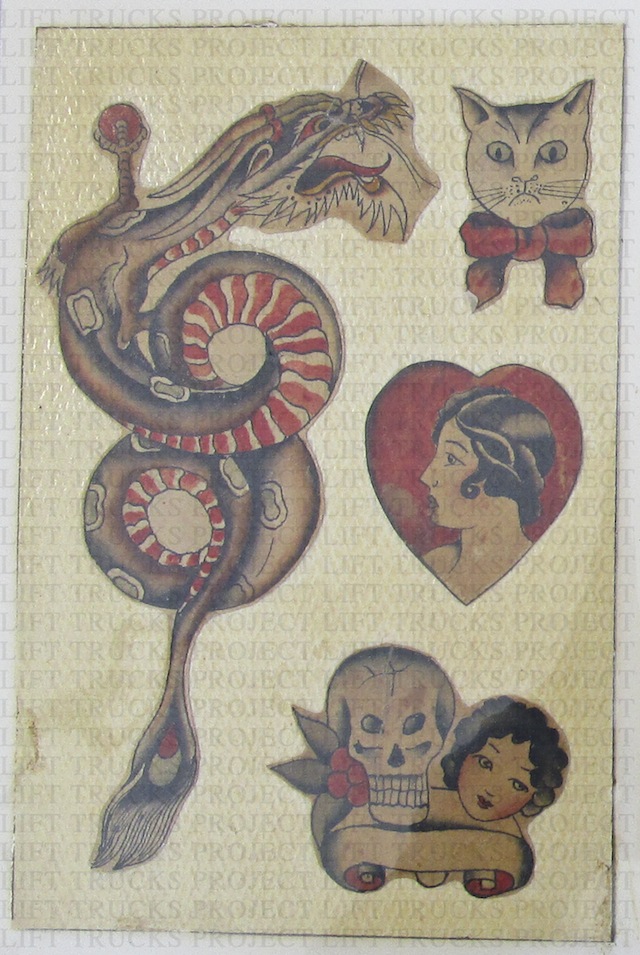
The fantasy drawing of a dragon is particularly compelling. A Japanese influence fish tail imparts the look of an angry eye. Even more peculiar is ol’ sour puss in the corner, all too reminiscent of the internet-famous Grumpy Cat (8.6 million fans on Facebook.) Even the scroll under the skull and girl looks like the back bumper of a 1960s land-yacht. Thomas Berg, we hardly knew you, but your timeless artwork aged beautifully.
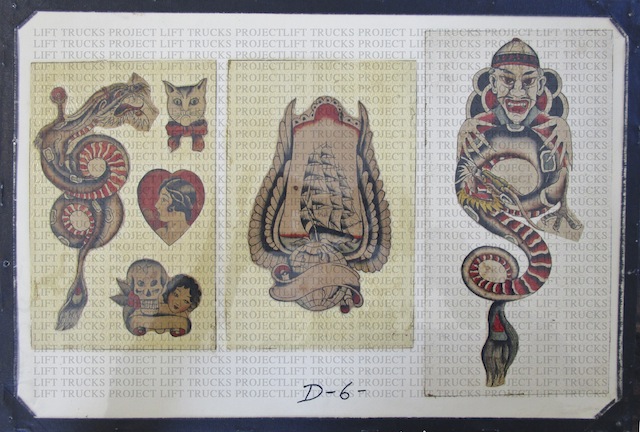
Pigtals no more when tattoos was tattoos: by Bob Crutch Crutchfield
Happy New Year , here are some pics from former crew members off my favorite Diesel Sub , these fellas sailed on her late 50s early 60s ,me late 60s early 70s....You can see Tats here in actual service at sea aboard,before Tats were considered K@@L haha,...one crewman with Swallows on chest another young crewman with name of boat/sub on his arm....and check out the Mohawk haircuts, the V8 one unique haha...you can`t do this stuff in modern Navy haha....even when I was in the Diesel Sub Force "Pigboat Navy " as they called us,45 yrs ago now, uniforms were lax at sea , some wore short pants,sandals and many of us sported beards...we were known as "Sewer Pipe" Sailors because we could take no baths aboard ,and we always smelled abit and alot like diesel (on leave once dancing slow with a gal she ask me what is that smell=it was the diesel you could not wash it out of your skin,it had to wear off ,..might add =she dealt with it haha). I did one 40+ day patrol N.Atlantic no bath...man did that hot water feel good in Boston Navy Yard base when we finally got into Port...... the pictures of boat diving taken thru periscope is mine taken on that N Atlantic patrol, swim call off Jamaica (my crewtimes) down in Caribbean, last pic myself and some of my shipmates on dock by the Boat ,and the newsclipping around 73 , the Amberjack was last of diesel boats to go down and our squadron SUBRON 12 was decommed = shutdown forever.... crutch
Sailor, Collector, Writer.
Bob Crutch Crutchfield




Yes Yes, And Furthermore...
Here's something we know. This sheet was done by Dusty Rhodes aka Professor Manley.
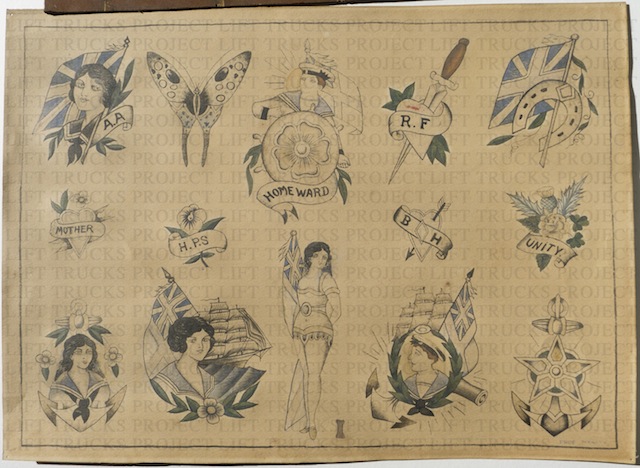
It's signed.

The dude's full name was Manley Raymond "Dusty" Rhodes (1890-1962.) Our professional research team at LTP confirms: The hand that wrought this had nothing at all to do with the big framed panel that hung in his studio.
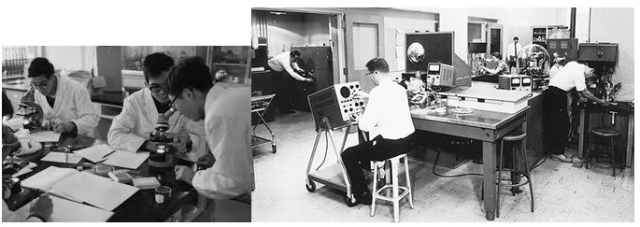
Compare the knives and faces.

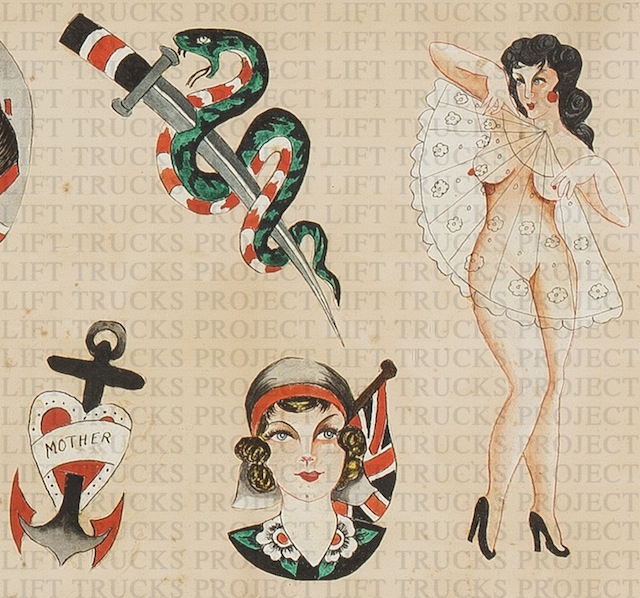
But as a wise collector once said: Let's just sit back and dig these tattoo masters. They are the true and real artists of the last Century.
Snakes and High Heels
From exhaustive electroscopic comparison analysis at our very own International Institute for Tattoo Art Research, a division of Lift Trucks Project, our studies have led us to the following determination. The large tattoo flash board from Dusty Rhodes studio is most certainly the handwork of Joseph Hartley.

One element of our research over the course of a couple of hours and in between other stuff, was to focus upon the written words. Lettering is, in itself, as telling and unique as a signature. No two people will pen a letter exactly the same way.

Selection from a book documenting Joseph Hartley work, by the esteemed expert, Mr. Hanky Panky.

A close up of the sheet found in Dusty Rhodes shop.
As we compare the individual letters in the word "NAME", note the outward curve on the right stroke of the “A" and the distinctive convex and concave lines on the "N". The way the center angle of the "M” does not descend as far as the other parts of the letter. Our research shows that in Hartley’s lettering most of the forms have the tops dramatically curving as if they’re leaning back and windswept.

Hanky Panky's book (Left) Dusty's sheet (Right)

Joseph Hartley sheet kindly sent by a Lift Trucks contributor. (Above.)

Board from Dusty's studio
We encourage our readers to look for these points of similarity. Snakes with distinct red/white underbelly's and black and green backs. Unique little dots around hearts. The women have stylized bright eyes, arched eyebrows, rosebud lips and heavy jaw lines... The final tells being the ladies tiny size 2 shoes and the fact that Hartely was well known to have supplied the Rhodes brothers in the 1930's with supplies from his Tattoo business in Bristol, England.
Just as sure as a clean fingerprint on a newly cracked safe, we believe this conclusively connects the art to the artist.
We also think this sheet is his ultimate masterpiece.
This of course, has nothing to do with the fact that we own the item.



